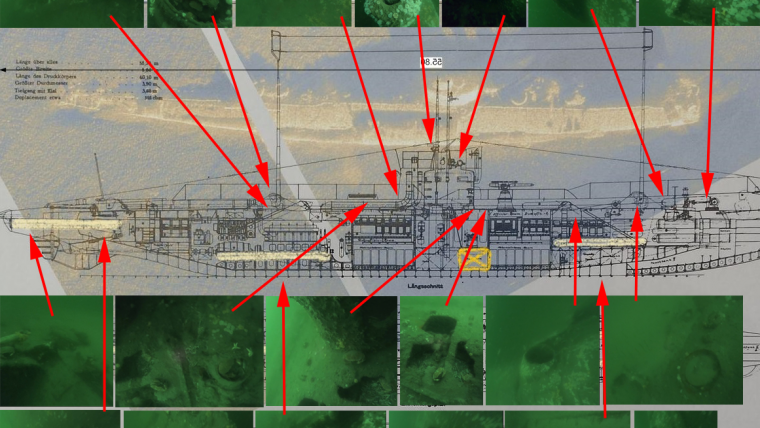Dangerous war remnants
Munitions and wrecks in the North Sea
Countless ships and aircraft were lost at sea in the two world wars. Many of these went down with a large amount of fuel and munitions onboard, not to forget the countless sailors and airmen who lost their lives and are entombed in the wrecks. After the wars, redundant ammunition was dumped in the sea, sometimes together with the ships that carried it to the dumpsite. As a result, there are many thousands of wrecks and many tons of conventional munitions and chemical warfare agents in the sea. The question is how these affect our everyday lives.
Potential dangers of wrecks
For a long time, the hazard mainly considered was the danger that the wrecks presented to shipping. Over the years, hydrographic offices logged the positions and minimum depths of the wrecks, to decide whether they pose a risk to shipping. Those considered to pose a considerable danger were removed, and the rest were marked on the nautical chart and with buoys where required.
However, two other hazards have come to light over the years. One is the potential explosion of unexploded conventional munition remnants (UXO). Of course, this is nothing new and regular UXO surveys are performed. However, these usually focus on areas of the bottom that are perceived as free from wrecks. As we are running out of space, however, the wrecks with munitions are gaining more attention. The other hazard is less clear and possibly more dangerous. As said, most ships went down with fuel and munitions onboard and, depending on their operations, they may have even had an almost full complement of both. Over the years, these wrecks have deteriorated. Steel which might have been brand new when the vessel sank is now over 100 years old for wrecks from WWI. However, not only the steel of the vessel deteriorates, but also the materials containing the explosives and the fuel tanks. Consequently, the chemicals contained are being released into the environment, but how much and to what effect?
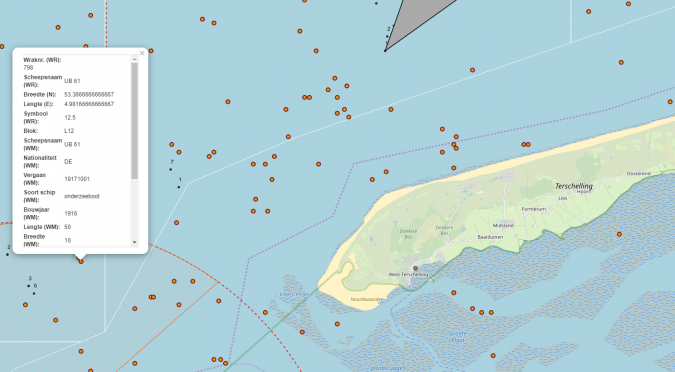
North Sea wrecks
To answer these questions, a European Interreg North Sea Region research project was started in 2018 called North Sea Wrecks with the aim of investigating this problem. The project is a cooperation between organizations in Belgium, the Netherlands, Germany, Denmark and Norway. As part of the research, each country is investigating several wrecks which may still contain dangerous materials in their respective areas of the North Sea. Research is being done by VLIZ in Belgium, the Maritime Institute Willem Barentsz (MIWB) in the Netherlands, the Alfred Wegener Institute in Germany, Aarhus University in Denmark, and the Defence Research Establishment (FFI) in Norway. The focus of the research is mainly on munitions, as least is known about the risks involved with these. The wrecks were selected using historical research with a focus on war history and the possible presence of munitions on board at the time of sinking.
Using historical records such as those in the German Shipping Museum (DSM) and the German Naval Archives, but also from local records and diving clubs, a survey and sampling campaign was built for each of the wrecks. In each area, several wrecks were surveyed using multibeam echosounder (MBES) and sidescan sonar (SSS) to verify the condition of the wrecks and assess the possibility of finding any remaining munitions. In the Netherlands, MIWB students selected four wrecks as possible contenders. After an initial survey in 2018/2019, two of these wrecks were found to be in such a bad shape that the chance of finding any munitions was considered small. The two other wrecks, a former Vorpostenboot (a patrol vessel) – the Max Gundelach from WWII – and the submarine UB-61 from WWI, were selected for further research.
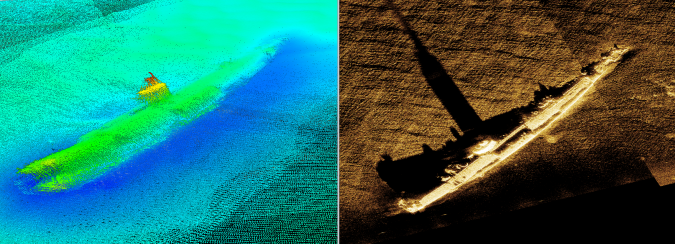
Using detailed records from the German Naval Archives, the war history of both wrecks was researched. The Max Gundelach was found to have been torpedoed by aircraft. During a short but intensive fight, part of the ammunition was used, but the depth charges and much of the smaller munitions were not used in the fight and should still be lying on or around the wreck. MBES surveys in 2020 and 2021 showed the wreck in recognizable shape, allowing a directed sampling campaign. The submarine UB-61 hit a mine early on its patrol and sank with all hands after the mine exploded at least two of the torpedoes in the bow. However, the stern was found to be fully intact during the 2020 and 2021 surveys and should still contain two torpedoes, according to the war records. A further synthetic aperture sonar (SAS) survey by the Royal Netherlands Navy vessel Geosea confirmed the state of both wrecks.
The next step was to perform extensive biochemical sampling. For all wrecks, this was mainly done using divers who not only took samples during their dive but also investigated the condition of the wrecks using video where possible. For the Max Gundelach and UB-61, the MIWB students developed a sampling campaign which was executed by the Royal Netherlands Navy in the summer of 2021 using the HNLMS Geosea and Schiedam and their dive teams.
Both bottom and water samples were taken at various distances around the wrecks or visible munitions in all countries. In addition, passive samplers and mussels were left on the wreck where possible. Both the mussels and the passive samplers (basically artificial mussels) function as water filtering membranes. During their time on the wreck, they filter the water and any chemical substances are absorbed into their membranes. After a few months on the wrecks, they are retrieved by divers and sent to the Institute of Toxicology at Kiel University. By analysing the membranes, the presence and total amount of chemical substances such as TNT and its derivates can be assessed.
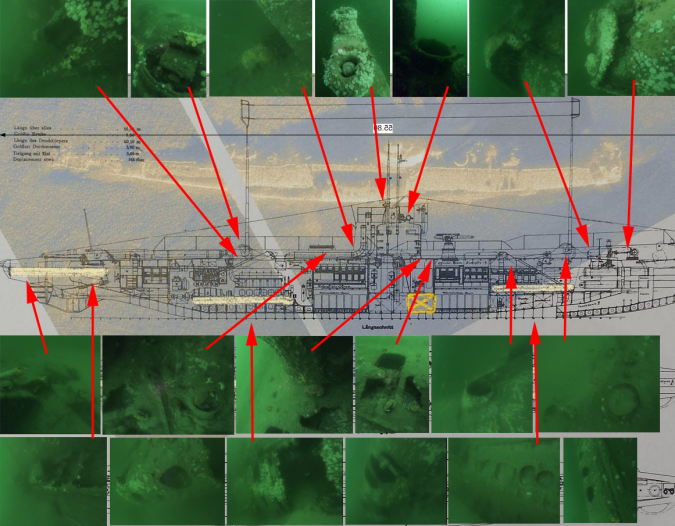
Dangerous or not?
The big question is not whether any chemical substances are leaking from the munitions, which can almost be guaranteed after 100 years in salt water, but how badly. This concerns not so much the amount that is leaking, but the danger that this presents to the environment in general and humans in particular. These substances are absorbed into the food chain where they can cause cancers and mutations, but the animals who absorb these substances are also eventually eaten by fish, which in turn are eaten by humans.
This danger is not simple to deduce, as the substances are discharged into the water surrounding the munitions and from there disperse. The stronger the currents, the faster the substances disperse and the lower the concentrations found. The research is focusing on determining the amounts that find their way into the food chain and therefore into human foodstuffs. The Institute of Toxicology at Kiel University is investigating the possible toxicological effects on humans.
Most of the samples have now been taken and some of them have been fully analysed. The results confirm the leakage of chemical substances such as TNT derivates from the munitions. However, the important questions are those concerning their toxicity to animals in general and humans in particular. So far, nothing conclusive can be said on the effects in the real world. In 2021, an additional grant was awarded to the North Sea Wrecks consortium to assess food safety more closely in relation to wrecks and munitions.
Legal complications
There are so many wrecks that it is hard to decide which ones to deal with first. However, another issue is that little is known about many of the wrecks at sea. Often in the past, only positions and depths were logged for the nautical chart. Sometimes we have a name, but rarely information on the cargo carried. One aspect of the project is to determine which information is available and should be collected in a database to assess the risk of the wrecks in terms of munitions and other dangerous substances. Periplus in the Netherlands and North.io in Germany are focusing on this part of the research and are developing a decision support system that will allow policymakers to determine which wrecks should take priority based on objective criteria.
In addition, while there are many national laws and international conventions concerning wrecks, it is unclear which law should take precedence in a certain situation. For example, a war wreck can be a war grave, a cultural historical object, a danger to navigation or a danger to the environment. Often, it is not a choice of one of these but a combination of factors. This legal complication is being further exposed as part of the work done by the MIWB within the project. Ideally, this should result in a clear decision framework on what to do with a certain wreck in a certain situation (based on the outcome of research and the decision support system). The issue is being discussed within the OSPAR EIHA committee and will hopefully result in the sharing of best practices and possibly a shared approach to the risk assessment of wrecks containing munitions.
Conclusions
The issue of hazardous wrecks is a complicated one. Currently, we do not know how big the problem is or even if we have a problem at all where the environment or food safety are concerned. More research is required, and a sound policy framework needs to be developed. A good start could be to start compiling a database, accessible for national authorities, of wrecks that are known to contain munitions so that more effective decisions can be made.
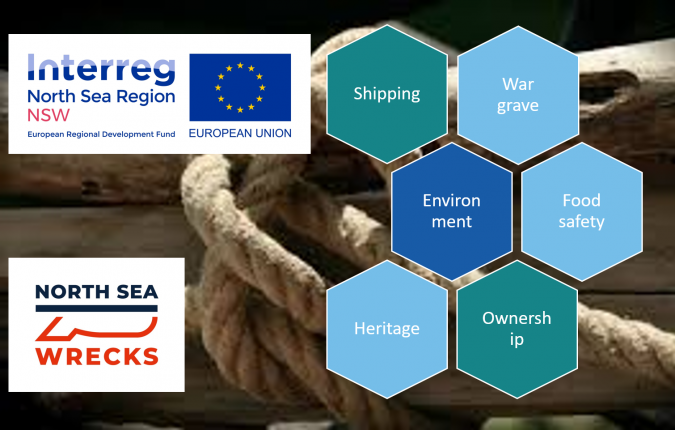

Value staying current with hydrography?
Stay on the map with our expertly curated newsletters.
We provide educational insights, industry updates, and inspiring stories from the world of hydrography to help you learn, grow, and navigate your field with confidence. Don't miss out - subscribe today and ensure you're always informed, educated, and inspired by the latest in hydrographic technology and research.
Choose your newsletter(s)
